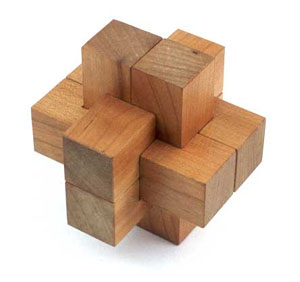
[Home] [Contents] [Figures] [Search] [Help]
[Next Page] [Prev Page] [ Next Chapter] [Prev Chapter]
The standard six-piece burr consists of six notched square sticks of arbitrary equal length not less than three times their width, arranged symmetrically in three mutually perpendicular intersecting pairs. If the square cross-section of the sticks has a dimension of two units, then all notches are one unit deep and one unit wide or some exact multiple. To put it another way, all notches can be regarded as being made by removal of discrete cubic units, or to put it still another way, all pieces can be regarded as being built of cubic units. All of the notches are made within the region of intersection with the other sticks, so that when the puzzle is assembled no notches show and it has apparent symmetry (Fig. 64).
Fig. 64
The six-piece burr is actually a large family of designs, since the designer has a wide choice of how to notch each of the pieces. Over the years, variations of the six-piece burr have received much attention from puzzle inventors and authors. Directions for making them can be found in many books and magazines. Several different versions have been manufactured and patented. The earliest US patent is No.1,225,760 of Brown, dated 1917, with several others following shortly thereafter. Most toy and novelty stores have a few burr puzzles on their shelves or in their catalogues. Traditionally, these have been uninspired time-worn versions with sliding key and internal symmetries. Consequently this fine puzzle has suffered a chronically tarnished image. To make matters worse, over the years many inventors have tinkered with bizarre embellishments to give the basic burr puzzle their own stamp of identity. The patent files reveal many such ill-conceived contraptions, including those with strings and holes, hidden pins, rotating keys, and other secret locking devices. Evidently taking their cue from certain composers of modern "music", they have thrown in odd intervals, incongruously sharpened or flattened pieces, confusingly large numbers of parts in hopeless disharmony with each other, and other jarring complications. Within the last decade or two, though, the six-piece burr has emerged from this decadent period to become once again the quintessential interlocking puzzle, thanks largely to the work of Bill Cutler.
There are twelve cubic units in each piece that are candidates for removal (Fig. 65). Removing these in all possible permutations would theoretically result in 4,096 different pieces, but by discarding symmetries and those that cut the pieces in two, the number of practical pieces is 837. No one knows how many different ways sets of six such pieces can be combined and assembled, but they number in the millions. Cutler limited his analysis to only those combinations that make a solid assembly with no internal voids. Using a computer, he found there are 369 usable pieces and they can be assembled into a solid burr 119,979 different ways. These results were published in the Journal of Recreational Mathematics, Vol. 10(4), 1977-78, and were summarized by Martin Gardner in Scientific American, Mathematical Games column, Jan. 1978.
Editor's Note: Bill Cutler continued his analysis of six-piece burrs culminating in the 1994 publication of A Computer Analysis of All 6-Piece Burrs. His analysis showed that there are roughly 35.65 billion possible assemblies (71.3 billion if mirror images are counted). Of these, 35.65 billion assemblies, 5.95 billion can be taken apart. The highest level found for a non-unique (more than one assembly) six-piece burr was 12. The highest level unique six-piece burr is 10 if the pieces are 8 units long and 9 if the pieces are 6 units long. If all pieces are notchable, the highest level is 5 for a unique burr. His analysis completely explored all assemblies for the first piece to be taken out. Only higher level burrs were completely analyzed. So the number of total solvable burrs is a statistical estimate.
Fig. 65
The burr pieces can be divided into two groups - those with simple notches that can be milled out directly with a saw or dado blade (notchable pieces), and those with blind corners and edges that must be chiseled out or made by gluing in cubic blocks (unnotchable pieces). The notchable pieces are the more desirable from both practical and aesthetic considerations. Some puzzle analysts have limited their investigations to notchable pieces, of which there are 59 (including the one with no notches). It has been customary to consider only solid assemblies, in which case there are only 25 usable notchable pieces, and these are commonly referred to as the set of 25 notchable pieces. They can be chosen in sets of six and assembled solid in 314 different ways. Some of this was calculated independently by several different analysts, with or without a computer. All of it has been confirmed and organized by Cutler.
In Fig. 66, piece A is notchable. Piece B is not notchable. Piece C can be made with a saw but cannot be assembled with other notchable pieces without producing voids, so it is not included in the set of 25 notchable pieces, which are shown in Fig. 67.
Fig. 66
Fig 67
| ©1990-2005 by Stewart T. Coffin For questions or comments regarding this site, contact the chief metagrobologist: |
[Next Page] [Prev Page] [ Next Chapter] [Prev Chapter]